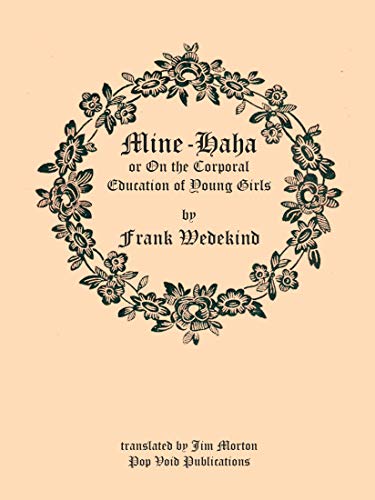 By FRANK WEDEKIND (Pop Void Publications; 2020)
By FRANK WEDEKIND (Pop Void Publications; 2020)
This isn’t the first English translation of Frank Wedekind’s 1903 German language novella MINE-HAHA, but it is (as of 2020) the most widely accessible. The translator was Jim Morton, best known to me as editor of the 1986 RE/Search Volume INCREDIBLY STRANGE FILMS. Thus it’s no surprise that Morton spends a great deal of his introduction discussing the films inspired by MINE-HAHA, namely Lucile Hadzihalilovic’s INNOCENCE and Dario Argento’s SUSPIRIA, although he does nonetheless evince a good understanding of the text, and does a fine job rendering Wedekind’s subtle-yet-descriptive prose into English (albeit not without some noticeable typos!).
The subject is a dystopian boarding school that was attended by the first-person protagonist, an old woman remembering her youth (with the story related in the form of a recollection told to the author by the old woman in question). Her highly episodic recounting, spanning seven especially formative years, contains no info on how she came to be enrolled in this bizarre institution or her attitude toward it; it’s simply accepted as an integral part of her world.
Such nonchalance fits the book’s frank, even-tempered tone. Dark and unpleasant though the story’s particulars sometimes are, the descriptions are unerringly matter-of-fact and unimpressed. This is something to which the narrator admits, claiming “I have no list of the marvels of beauty and sensual delights from my later years to report. They stopped in my memory the moment I ceased being a child.”
The sequestered girls of this school, or “compound,” are trained in how to be ladylike. This includes a great deal of strenuous exercise, musical instruction and forced marching—with a switch utilized to ensure the girls carry out their assignments correctly. Far worse punishments are in store, as when the protagonist is forced to spend a night enclosed in a tiny box. There’s also a hushed-up drowning, a surreal passage in which a box is dropped off from which a future student named Betty emerges, a singularly bizarre play the girls perform and the protagonist’s coming of age, in which she goes from being a victim of the compound’s abuse to a perpetrator.
That Wedekind was a proto-feminist is evident throughout the book, and in its none-too-concealed subtext. Prudish early Twentieth Century literary standards prevented Wedekind from exploring his overriding theme, of a young woman’s maturation in a male-dominated society, in too literal a fashion, but it shines through nonetheless. So too the barely-suppressed hints of homosexuality, which are evident in the descriptions of the pupils and their instructors, one of whom so enraptures the narrator that “I walked around in a half-slumber during which I could only see her face.”
This brings us to perhaps the book’s most impressive aspect: its entirely convincing depiction of a woman’s point of view (something with which male writers generally have trouble), making this a very rare example of male-essayed feminism done right.
